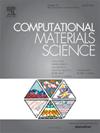Relating the formation energies for oxygen vacancy defects to the structural properties of tungsten oxides
IF 3.1
3区 材料科学
Q2 MATERIALS SCIENCE, MULTIDISCIPLINARY
引用次数: 0
Abstract
Tungsten is one of the materials of choice for several commercial fusion power plant designs, in particular, for divertor targets and the first wall. In maintenance conditions or during a loss of coolant accident, tungsten is expected to reach temperatures at which it readily volatilises as tungsten trioxide, potentially distributing radioactive material and posing a hazard to personnel. The oxidation of tungsten is reported to show an orientation dependence, however, the mechanism by which it occurs is not fully understood, providing an obstacle to the development of tungsten smart alloys that display reduced oxidation. Using DFT+ simulations, it is shown how key features of the electronic structure of the tungsten–oxygen system change as the tungsten–oxygen ratio evolves. Formation and migration barriers for oxygen in the different tungsten oxides are determined, allowing an assessment of its mobility in the phases observed during the oxidation process. Our results provide a new level of understanding of the sub-stoichiometric Magnéli phases that are observed during the oxidation of tungsten, which are perceived to be composed of WO2- and WO3-like regions.

求助全文
约1分钟内获得全文
求助全文
来源期刊

Computational Materials Science
工程技术-材料科学:综合
CiteScore
6.50
自引率
6.10%
发文量
665
审稿时长
26 days
期刊介绍:
The goal of Computational Materials Science is to report on results that provide new or unique insights into, or significantly expand our understanding of, the properties of materials or phenomena associated with their design, synthesis, processing, characterization, and utilization. To be relevant to the journal, the results should be applied or applicable to specific material systems that are discussed within the submission.
 求助内容:
求助内容: 应助结果提醒方式:
应助结果提醒方式:


